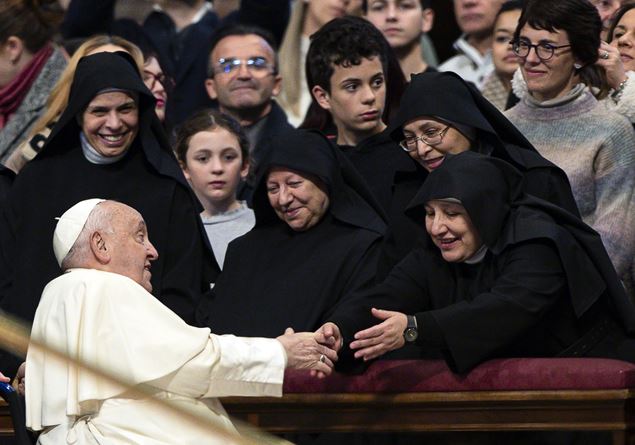In the homily of the Epiphany Mass celebrated in St. Peter’s Basilica, Pope Francis recalls the profound meaning of the star that guided the Magi: a light visible to all, which illuminates the path towards God and invites universal love. “God seeks everyone, always,” underlines the Pontiff, recalling that the Christian mission is to eliminate every form of exclusion and build spaces of welcome and sharing. Francis urges us to reflect on the power of God’s love, which “illuminates and warms, allowing itself to be consumed”, and encourages us to be “for each other, lights that lead to the encounter with Christ”. The star is a sign of hope that overcomes barriers and reaches every corner of the earth, to tell everyone that “God does not deny himself to anyone”. In conclusion, the Pope invites us to undertake an interior journey, to free the heart from what is not charity and bring the light of his love into the world.
Below is the text of the homily
«We saw his star rise and we came to worship him» (Mt 2,2): this is the testimony that the Magi give to the inhabitants of Jerusalem, announcing to them that the king of the Jews has been born.
The Magi testify that they set out on a journey, giving a turning point to their lives, because they saw a new light in the sky. We can then stop to reflect on this image, as we celebrate the Epiphany of the Lord in the Jubilee of Hope; and I would like to underline three characteristics of the star that the evangelist Matthew tells us about: And bright, And visible to all And indicates a path.
First of all the star is bright. Many rulers, at the time of Jesus, called themselves “stars”, because they felt important, powerful and famous. However, it was not their light – that of any of them – that revealed the miracle of Christmas to the Magi. Their splendor, artificial and cold, the result of calculations and power games, was unable to respond to the need for novelty and hope of these people in search. He did it instead another type of lightsymbolized by the star, which illuminates and warms by burning and allowing itself to be consumed. The star speaks to us of the only light that can show everyone the path to salvation and happiness: that of love. That is the only light that will make us happy.
First of all the love of God, who by becoming man gave himself to us by sacrificing his life. Then, consequently, the one with which we too are called to spend ourselves for each other, becoming, with his help, a mutual sign of hope, even in the dark nights of life. We can think about this: are we bright in hope? Are we capable of giving hope to others with the light of our faith?
Just as the star, with its shining, guided the Magi to Bethlehem, so we too, with our love, can bring the people we meet to Jesus, making them know, in the Son of God made man, the beauty of the Father’s face ( see Is 60.2) and his way of loving, made of closeness, compassion and tenderness. Let us never forget this: God is close, compassionate and tender. This is love: closeness, compassion and tenderness. And we can do it without the need for extraordinary tools and sophisticated means, but by making our hearts luminous in faith, our glances generous in welcoming, our gestures and our words full of kindness and humanity.
Therefore, while we look at the Magi who, with their eyes turned to the sky, seek the star, we ask the Lord to be, for each other, lights that lead to the encounter with Him (cf. Mt 5,14-16). It is bad that a person is not a light for others.
And so we come to the second characteristic of the star: it it is visible to everyone. The Magi do not follow the indications of a secret code, but a star that they see shining in the firmament. They notice it; others, like Herod and the scribes, do not even notice his presence. However, the star always remains there, accessible to anyone who looks up to the sky, looking for a sign of hope. Am I a sign of hope for others?
And this is an important message: God does not reveal himself to exclusive circles or to a privileged few, God offers his company and his guidance to anyone who seeks him with a sincere heart (see Sal 145.18). Indeed, he often anticipates our own questions, coming to look for us before we even ask him (see Rm 10.20; Is 65.1). Precisely for this reason, in the nativity scene, we represent the Magi with characteristics that embrace all ages and all races – a young person, an adult, an elderly person, with the somatic features of the various peoples of the earth -, to remind us that God seeks everyone, always . God seeks everyone, everyone.
And how much good it does us to meditate on this today, in a time where people and nations, despite being equipped with increasingly powerful means of communication, seem to have become less available to understand, accept and meet each other in their diversity!
The star, which offers its light to everyone in the sky, reminds us that the Son of God came into the world to meet every man and woman on earth, to whatever ethnicity, language and people they belong to (see At 10.34-35; Ap 5.9), and who entrusts the same universal mission to us (see Is 60.3). That is, it calls us to ban any form of selection, marginalization and discarding of people, and to promote, within ourselves and in the environments in which we live, a strong culture of welcome, in which the locks of fear and rejection open spaces for meeting, integration and sharing are preferred; safe places, where everyone can find warmth and shelter.
This is why the star is in the sky: not to remain distant and unreachable, but on the contrary so that its light is visible to everyone, so that it reaches every home and overcomes every barrier, bringing hope to the most remote and forgotten corners of the planet. He is in heaven to tell everyone, with his generous light, that God does not deny himself to anyone, does not forget anyone (see Is 49.15). Why? Because he is a Father whose greatest joy is to see his children returning home, united, from every part of the world (see Is 60.4), see them building bridges, paving paths, looking for those who are lost and carrying on their shoulders those who struggle to walk, so that no one is left out and everyone participates in the joy of their home.
The star speaks to us of God’s dream: that all humanity, in the richness of its differences, comes to form a single family living in harmony in prosperity and peace (see Is 2,2-5).
And this brings us to the last characteristic of the star: that of show the way. This too is food for thought, especially in the context of the Holy Year we are celebrating, in which one of the characteristic gestures is the pilgrimage.
The light of the star invites us to undertake an interior journey which, as John Paul II wrote, frees our hearts from everything that is not charity, to «fully encounter Christ, confessing our faith in Him and receiving the abundance of his mercy” (Letter to those who are preparing to celebrate the great Jubilee in faith29 June 1999, 12).
Walking together «is typical of those who search for the meaning of life» (see Bolla Spes non confundit5). And we, looking at the star, can also renew our commitment to being women and men “of the Way”, as Christians were defined at the origins of the Church (see At 9.2).
May the Lord thus make us lights that point to Him, like Mary, generous in giving to us, open in welcoming and humble in walking together, so that we can meet him, recognize him and adore him, and start again from Him renewed, bringing the light of his love into the world.









